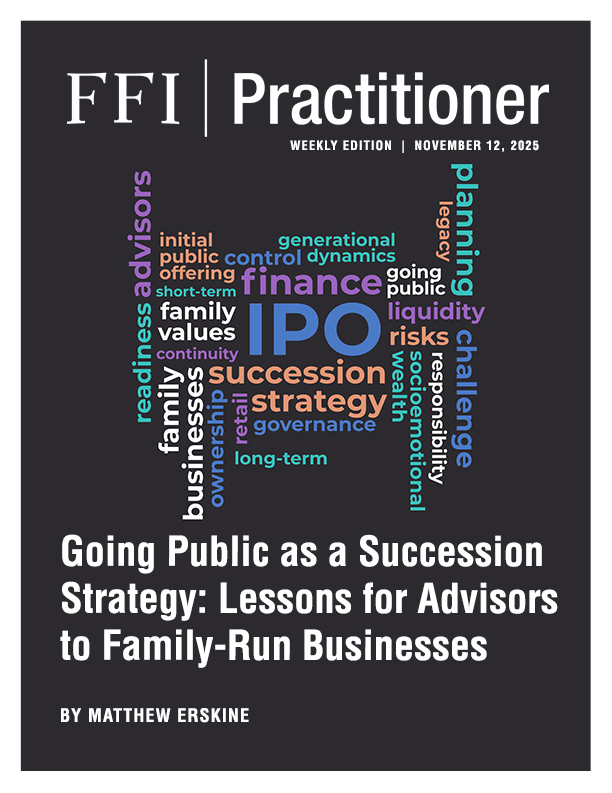
Introduction
For family-run enterprises, the decision to go public is never purely financial. It is a pivotal moment in succession planning, one that reshapes ownership, governance, and the family’s socioemotional wealth (SEW). A précis by FFI Fellow Rocki-Lee DeWitt in a recent edition of FFI Practitioner1 is an excellent introduction to the study by Carbone et al.2 (“the Study”) in Family Business Review, which explores why and how family firms undertake an initial public offering (IPO) through the lens of SEW, offering practical insights for succession planning. This white paper distills the study’s findings and outlines the implications for advisors to families considering whether to take their business public as part of their long-term legacy strategy, and a brief checklist based on the study.
Why Family Firms Consider an IPO
Carbone et al., found that family firms follow three distinct paths when going public:
- Shine Path: Families pursue IPOs to finance growth and professionalize governance while preserving potential control and succession opportunities. For these firms, control, family identity, and intergenerational continuity are paramount.
- Continue Path: Families use IPOs to ensure the firm’s survival beyond family ownership, emphasizing obligations to employees, stakeholders, and community legacy. This path reflects a broader definition of continuity, one that extends beyond bloodlines.3
- Challenge Path: Often driven by members of younger generations, this path uses IPOs as a means of self-affirmation and strategic redirection. While it can invigorate the business, it also risks misalignment between personal aspirations and market realities, sometimes leading to post-IPO dissatisfaction.4
Implications for Succession Planning
The research underscores that advisors should consider IPOs as succession milestones as much as financing events:
- Integration with Succession Strategy: IPOs can provide liquidity, finance acquisitions, and institutionalize governance. For founders, these often coincide with grooming successors. For heirs, IPOs can provide a platform for asserting their new leadership.5
- Generational Dynamics: First-generation owners view IPOs as a way to balance growth with control (Shine), while later generations may see them as opportunities for reinvention (Challenge). Advisors must identify whether IPO motives stem from business needs or personal ambitions.6
- Preserving Socioemotional Wealth (SEW): Families may consider financial trade-offs (such as share pricing strategies) to balance control, reputation, and legacy considerations. Understanding what form of SEW—control, identity, or stakeholder responsibility—is most valued will determine whether IPO is the right path.7
- Risks of Misalignment: Market pressures that are outside of the family’s control (e.g., pricing, transparency, investor expectations) often clash with family priorities. IPOs response to these market forces can become sources of frustration and conflict, undermining both financial returns and family harmony.8
Checklist: Preparing for an IPO as Part of Succession
The following factors may be relevant when considering an IPO strategy (this list is not exhaustive and should not be considered as legal or financial advice):
A. Family Readiness
- What is the family’s common goal: control, legacy, liquidity, or continuity?
- Is each generation aligned, or is the IPO primarily a personal project of one or a few individuals?
- Are there governance frameworks (family council, constitution, shareholder agreements) in place?
- Does the family, both collectively and individually, have the available emotional and financial resources necessary to sustain the family during the IPO process?
B. Business Readiness
- Does the business have the governance structures and management depth to meet public market scrutiny?
- What is the current state of financial reporting, compliance, and operational readiness relative to public company requirements?
- What are the firm’s capital needs (growth, acquisitions, deleveraging) and its resources to meet those needs?
C. Socioemotional Wealth (SEW) Considerations
- How important is retaining family control post-IPO?
- How much weight is given to stakeholder responsibility versus shareholder value?
- Does the IPO support long-term succession or short-term self-affirmation?
D. Market & Investor Considerations
- Which investor types (institutional, strategic, retail) align best with family values?
- Is the family prepared for the transparency, scrutiny, and loss of privacy that comes with being public?
- Does IPO timing align with market conditions and the family’s succession cycle?
E. Alternatives to IPO
- Could private equity, debt financing, or strategic partnerships achieve similar goals without a public listing?
- Would a dual-class share structure or partial IPO balance liquidity with family control?
Conclusion
Going public is not simply a financial event; it is a family governance decision with far-reaching implications for identity, control, and legacy. Families must agree upon which of the three paths—Shine, Continue, or Challenge—best reflects their priorities. Professional advisors, working within their respective areas of expertise and applicable regulations, help align financial considerations with socioemotional wealth objectives as part of the succession planning process.
By considering IPOs within the broader context of succession planning, families, with appropriate professional guidance, can evaluate how such strategies may affect both their financial and non-financial objectives.
References
1 Rocki-Lee DeWitt, “Research Applied: An FBR Précis on ‘Why and How Do Family Firms Go Public? A Socioemotional Wealth Perspective of IPO,’” FFI Practitioner, August 20, 2025, https://ffipractitioner.org/research-applied-an-fbr-precis-on-why-and-how-do-family-firms-go-public-a-socioemotional-wealth-perspective-of-ipo/.
2 Emmadonata Carbone et al., “Why and How Do Family Firms Go Public? A Socioemotional Wealth Perspective of IPO,” Family Business Review 37, no. 4 (2024): 413–415, https://doi.org/10.1177/08944865241273380.
3 Carbone et al., 415-417.
4 Carbone et al., 416-419.
5 Carbone et al., 418-420.
6Carbone et al., 421-423.
7 Carbone et al., 419-422.
8 Carbone et al., 423-425.





